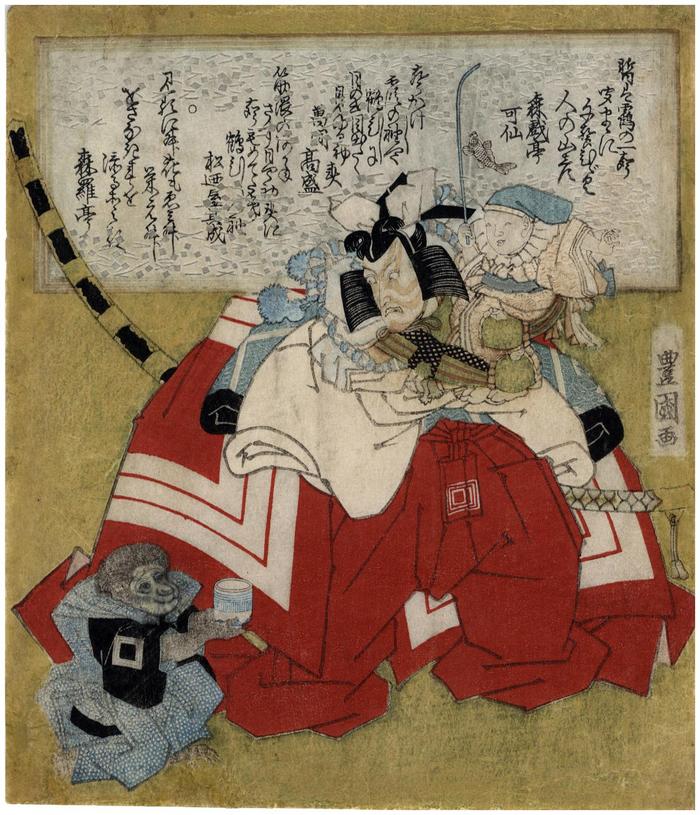Utagawa Toyokuni I (初代歌川豊国) (artist 1769 – 02/24/1825)
Ichikawa Danjūrō VII (市川団十郎) in Shibaraku (暫), with a child in the role of Ebisu and a monkey
1824
7 in x 8.25 in (Overall dimensions) Japanese color woodblock print
Signed: Toyokuni ga (豊国画)
Museum of Fine Arts, Boston
Achenbach Foundation for Graphic Arts
Museum für Kunst und Gewerbe, Hamburg
Berkeley Art Museum and Pacific Film Archive at the University of California
San Diego Museum of Art Barbara E. Thornbury noted that starting with Danjūrō II the kabuki season opened in 1714 with a production of Shibaraku coinciding with the kao-mise or 'face-showing ceremony'. Danjūrō I had performed in Shibaraku previously, but not with the opening of the season. Thornbury also noted that productions of this play were recreated every year and therefore were never exactly the same until the script was codified in print in 1895.
****
The actor Ichikawa Danjūrō VII wearing kumadori make-up in a 'Shibaraku' interlude holding his son, the future Ichikawa Danjūrō VIII. At their feet is a monkey wearing a kamishimo, offering them refreshments. Above them are four kyoka poems all with New Year's wishes. Another copy of this surimono from the H.R.W. Kuhne collection sold at Sotheby's on June 11, 1993, lot 306.
"The actor Ichikawa Danjūrō VII dressed for a heroic role, holds his new-born son, protectively and stares down at a monkey holding a porcelain incense burner. 1824. A white monkey was the Ichikawa clan's totem animal....
This print was privately commissioned. The panel behind the actor contains poems by Shingitei Kasen, Yorozunoto Takamori, Matsunoya Sorenari, and Shinratei Manzō."
Quoted from: The Male Journey in Japanese Prints by Roger Keyes, University of California Press, 1989, page 16. The illustrated example shown in black and white in this book comes from the Achenbach Foundation for Graphic Arts in San Francisco.
****
Shinratei Manzō (森羅亭万象 - 1760-1831) was the leader of a poetry group. The mark to identify their group, the Manjiren, was a swastika, but it does not appear here even though it does appear on other surimono prints. This group's poems also appear on works by Kōsetsu, Hokusai, Hokkei,Toyokuni I, Eisen and Shinsai.
The Tikotin Museum in Haifa says: "The first work Toyokuni signed with this name was an illustration for a novel written in 1786 by Shinratei Manzo."
****
The text reads:
「暫は鶴の一声聞まゝに又声ひゞく人の山彦 森戯亭歌仙」「声かけ霞の袖や鶴ひしに日の出目出たく見ゆる初春 万間高盛」「筋隈のあかねさす日や初春に声もめてたき鶴ひしの袖 松廼屋其成」「見るに升花もゑみ升栄え升をさなき春を添るそゝ★ 森羅亭」
****
The Museum of Fine Arts, Boston, attributes this print to Toyoshige (aka Toyokuni II) and dates it to 1827. The Museum für Kunst und Gewerbe in Hamburg concurs.
surimono - 摺物 (genre)
Ichikawa Danjūrō VII (七代目市川團十郎: 11/1800 to 2/1832) (actor)
Ichikawa Danjūrō VIII (八代目市川団十郎: 3/1832 - 6/8/1854) (actor)
